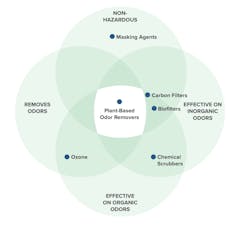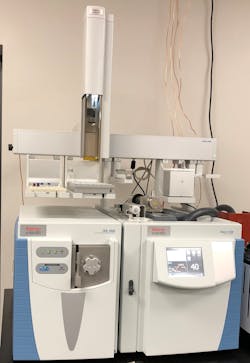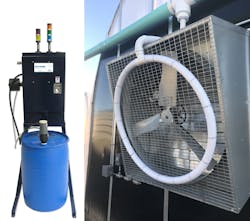Cannabis is here to stay, its unpleasant odors are not
In the worlds of manufacturing and processing, odor control is an often-overlooked topic, only considered after bringing a facility online as complaints from neighbors roll in. This subject deserves more attention during facility design in many industries, given how frequently odors are problematic, but it is especially worthy of consideration in the cannabis growing and processing business.
When in the flowering phase, marijuana plants (Figure 1) produce a scent referred to as pungent, skunky, floral, fruity or even “sewer-like,” and this smell is amplified in greenhouses and cultivation areas when handling large crops. A terpene called myrcene, which some strains of marijuana contain in very high concentrations, is a contributor to the odor, and sulfur-containing compounds within and outside of grow facilities are the primary source.
This smell can be far-reaching, often detected more than a mile from a cultivation area or greenhouse, and local governments are increasing efforts to reduce or eliminate it. For these reasons, companies must often create an odor mitigation plan before opening, and they are subject to hefty fines in many locales if odors are noticeable, especially if neighboring residents complain.
To combat offensive odors and corresponding fines, many companies attempt to cover up the smells, but this is not an effective practice because simply masking odors is a temporary solution. Proper odor management requires neutralizing unpleasant smells by altering their molecular makeup. This can be accomplished using custom formulations of modern plant-based odor removers, effective in greenhouses, processing facilities and other cannabis-related applications.
Odor mitigation challenges
Cannabis odor is a complex mixture of chemicals, and the scent typically comes from the terpenoids and terpenes it contains. Terpenoids can be further classified into monoterpenoids, sesquiterpenoids, diterpenoids and triterpenoids — each of which are acyclic, monocyclic or polycyclic hydrocarbons — with all contributing to odors.
Additionally, recent studies have determined the presence of sulfur-containing compounds in the air around cannabis facilities. These compounds, even at low concentrations measured in the parts per billion, can contribute heavily to strong and offensive odors.
Complicating mitigation matters, the concentrations and combinations of odorous chemicals vary from one facility to the next. Because these smells and their chemistry vary, there is no single odor solution that works for every application.
As the cannabis industry expands, many municipalities are imposing restrictions on the methods employed by commercial growers to handle odors. Particularly in urban areas, large-scale ventilation systems that pump untreated air outdoors are widely prohibited, so some facilities turn to industrial filtration systems — but these are costly to install, operate and maintain. Sealing a greenhouse is an alternative option, but this can cause overheating and harmful humidity increases.
There are several odor control methodologies used across multiple industries, but traditional solutions each have shortcomings in various forms. These methods include masking agents, chemical scrubbers, adsorption and carbon filters, ozone, biological filters and others (Figure 2).
While ozone — a powerful oxidant and anti-microbial — can be used to effectively remove odors from greenhouses, it causes side effects when used around humans, requiring facility evacuation during and after use. This is disruptive to operations and requires an excessive level of scheduling and planning. Additionally, ozone is highly caustic, and it can cause damage in the accidental presence of other chemicals.
Most cannabis greenhouses use carbon filters to remove odors emitted from the facility. These filters work by pushing a contaminated air stream through activated carbon. Carbon is porous, providing it with a large surface area, enabling absorption of the odorous chemicals.
Activated carbon filters work well on sulfur-rich compounds, but they are not as effective at treating nitrogen-based compounds. They also require annual or more frequent replacement, resulting in high ongoing maintenance costs. Carbon filters also restrict airflow through greenhouse fans, and because airflow is vital to growing, additional fans are often required.
Other traditional odor control methodologies require equipment, materials, setup and maintenance from multiple partners, and these complexities can render systems unwieldy and costly to operate.
Plant-based solutions
To address these and other issues, many growers and processers are turning to modern plant-based odor removers for safe and effective odor neutralization. These formulations are research-based, optimized to chemically react with and neutralize odor-causing components at the molecular level. For example, OMI Industries supplies its environmentally friendly Ecosorb CNB 204 product, which is specially formulated to substantially reduce the odor-causing chemicals in cannabis facilities. It is vaporized and distributed at growing and processing facilities through various delivery systems, and it can be combined with existing carbon and other filtration systems.
To develop effective neutralization products, scientists begin by collecting and studying gaseous samples from facilities using gas chromatography mass spectrometry (GC-MS) to determine the precise molecular makeup of odors, even those present in minute amounts (Figure 3).
A GC chromatogram (Figure 4) is a visual output of the data recorded by the detector, and it is presented as a plot of detector response (y-axis) versus retention time (x-axis).
Each compound detected appears as a single peak on the graph, with the corresponding retention time value used for identification. Once the odor-causing compounds are identified, OMI scientists concoct a formulation using plant oils to molecularly neutralize the odors when the compound is combined with odors in the atmosphere.
This results in versatile and cost-efficient solutions — specially crafted for maximum effectiveness in each application — with each leveraging customized concentrations of plant oils, biobased surfactants and water to eliminate odors. This includes those caused by cannabis, cannabinoids, terpenes, sesquiterpenes and sulfur-containing compounds.
Delivery via vaporization
Distributed during growth and processing, these plant-based odor removers absorb cannabis odors at the source, rather than masking the odors with synthetic fragrances or harsh chemicals. Additionally, these natural formulations are safe for use around people and animals, eliminating downtime when used periodically, and allowing for continuous use when required.
Vapor phase systems pump undiluted odor eliminators through perforated pipe distribution systems, creating a dry vapor to eliminate airborne odors on contact at their point of exhaust from a facility (Figure 5).
These systems deliver dry odor eliminator at rates as low as 130 cubic feet per minute (CFM) to as high as 2,400 CFM, making them adaptable to many locations and applications. These flexible and efficient delivery systems:
- Produce small droplets and high absorption for stable odor control.
- Require no mixing or water dilution onsite to operate.
- Can be provided with service contracts to relieve the facility of most maintenance tasks.
Odor control at a cultivation facility
When a cannabis enterprise planned a state-of-the-art 4,000-square-foot marijuana cultivation facility for growing, processing and producing edible products, they knew there was a need for odor control. Located in a busy commercial area — within a mile of residential neighborhoods, apartment complexes, restaurants, retail stores, schools and golf courses — the enterprise needed a solution to eliminate all traces of odor.
Despite the legality of cannabis in the facility’s state, the owners did not wish to draw negative attention, such as complaints from neighboring businesses or residents. And in compliance with city zoning bylaws for permitting, the owners were required to guarantee they would not emit “noxious, harmful or hazardous” odors into the surrounding neighborhood.
To mitigate escaping odors, the company invested in an internal charcoal filtration system to remove odors, while recirculating air inside the facility. It also installed UV technology in the exhaust pipes to kill organic odor-causing bacteria, and it fitted the roof with a complete perimeter vaporization system delivering Ecosorb CNB 100 to absorb remaining traces of escaping odors.
The perimeter system continuously mists dry odor removal vapor to scrub remaining smells from the air before they leave the facility’s vicinity. The CNB 100 blend of plant oils is chemically crafted to neutralize the complex odor molecules produced by cannabis plants. With its natural ingredient composition and ability for delivery without water dilution, OMI Industries’ Ecosorb CNB 100 provides a safe, effective and environmentally friendly means of odor control — with minimal required maintenance.
As demonstrated by minimal complaints from neighbors, the odor control system is performing its job successfully.
Odor mitigation for a CBD manufacturer
Another cannabis processor — a cannabidiol (CBD) manufacturing company that produces 1,000 Kg/month of CBD oil and a growing number of CBD products — did not anticipate such malodorous exhaust at the outset of its operations. In a short span after opening, the manufacturer received an alarming number of odor complaints from nearby residents and businesses, and local authorities threatened to shut its doors.
The manufacturer experimented with multiple products to cut down the distinct and potent smells, but after six months of unsuccessful trial and error, the processor turned to OMI Industries for its odor mitigation expertise. By pulling air samples from the facility and analyzing them using GC-MS, OMI’s Ecosorb team identified their CNB 204 solution as the best product for odor removal.
Two 75 CFM vaporization units were installed at the facility exhaust areas, pumping the proven blend of plant-based odor eliminators into the air to neutralize smells long before reaching the surrounding residents and businesses.
The manufacturer quickly learned to vary the volume of Ecosorb used based on odor control needs — greatest when marijuana is in its flowering phase and during intense intervals of processing, and less during other times.
When polled five months after adopting Ecosorb vapor phase CNB 204, the manufacturer and surrounding community reported a substantial improvement. Notably, the community no longer notices the manufacturer’s presence, empowering it to operate without the threat of being forced out of business.
Eco-products empower business continuity
By applying plant-based odor removers to facility exhaust or around the perimeter, processors can effectively mitigate foul odors in a variety of industries — including cannabis — using safe, environmentally friendly and cost-efficient methods. These custom formulations do not mask smells, but instead eliminate them by breaking down and neutralizing odor-causing molecules.
These odor management systems are simpler to operate and maintain than traditional odor control methodologies, and their use of renewable and biobased ingredients enables clean and environmentally conscious operation. By adopting these systems, cannabis growers and processors can significantly improve community relationships, and redirect focus from fielding complaints to growing their business.
Laura Haupert, Ph.D., is the chief scientific officer for OMI Industries, where she leads research and development, regulatory, safety and quality control.
OMI Industries
About the Author
Laura Haupert
Chief scientific officer for OMI Industries
Laura Haupert, Ph.D., is the Chief Scientific Officer for Ecosorb, where she leads research and development, regulatory, safety, and quality control. She earned her B.S. in chemistry from Manchester College and Ph.D. in physical chemistry at Purdue University, working with bond energies of solvated clusters. Dr. Haupert also completed her post-doctoral research at Purdue where she focused on the development of mass spectrometric methods for the structural elucidation of lignin catalytic degradation. Dr. Haupert has developed and directed Ecosorb’s many product lines—and she has overseen the state-of-the-art laboratory and production facility in Rising Sun, Indiana—for over ten years.




